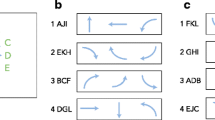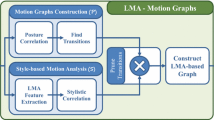Abstract
We present a learning-based method for the estimation of skill levels from sequences of complex movements in sports. Our method is based on a hierarchical algorithm for computing spatio-temporal correspondence between sequences of complex body movements. The algorithm establishes correspondence at two levels: whole action sequences and individual movement elements. Using Spatio-Temporal Morphable Models we represent individual movement elements by linear combinations of learned example patterns. The coefficients of these linear combinations define features that can be efficiently exploited for estimating continuous style parameters of human movements. We demonstrate by comparison with expert ratings that our method efficiently estimates the skill level from the individual techniques in a ”karate kata”.
Access this chapter
Tax calculation will be finalised at checkout
Purchases are for personal use only
Preview
Unable to display preview. Download preview PDF.
Similar content being viewed by others
References
Bobick, A.F., Davis, J.: An appearance-based representation of action. In: Proceedings of the IEEE Conference on Pattern Recognition, pp. 307–312 (1996)
Brand, M.: Style machines. In: SIGGRAPH (2000)
Bruderlin, A., Williams, L.: Motion signal processing. In: SIGGRAPH, pp. 97–104 (1995)
Caelli, T., McCabe, A., Binsted, G.: On learning the shape of complex actions. In: International Workshop on Visual Form, pp. 24–39 (2001)
Galata, A., Johnson, N., Hogg, D.: Learning variable lenth markov models of behavior. Journal of Computer Vision and Image Understanding 81, 398–413 (2001)
Gavrila, D.M.: The visual analysis of humanmovement: a survey. Journal of Computer Vision and Image Understanding 73, 82–98 (1999)
Giese, M.A., Poggio, T.: Synthesis and recognition of biological motion pattern based on linear superposition of prototypical motion sequences. In: Proceedings of IEEE MVIEW 1999 Symposium at CVPR, Fort Collins, pp. 73–80 (1999)
Giese, M.A., Poggio, T.: Morphable models for the analysis and synthesis of complex motion patterns. International Journal of Computer Vision 38(1), 59–73 (2000)
Ilg, W., Giese, M.A.: Modeling of movement sequences based on hierarchical spatialtemporal correspondence of movement primitives. In: Workshop on Biologically Motivated Computer Vision, pp. 528–537 (2002)
Moeslund, T.B.: Asurvey of computer vision-based human motion capture. Journal of Computer Vision and Image Understanding 81, 231–268 (2001)
Mori, T., Uehara, K.: Extraction of primitive motion and discovery of association rules from motion data. In: Proceedings of the IEEE International Workshop on Robot and Human Interactive Communication, pp. 200–206 (2001)
Unuma, M., Anjyo, K., Takeuchi, R.: Fourier principles for emotion-based human figure animation. In: SIGGRAPH, pp. 91–96 (1995)
Wilson, A.D., Bobick, A.F.: Parametric hidden markov models for gesture recognition. IEEE Transactions on Pattern Analysis and Machine Intelligence 21(9), 884–900 (1999)
Witkin, A., Popovic, Z.: Motion warping. In: SIGGRAPH, pp. 105–108 (1995)
Yacoob, Y., Black, M.J.: Parameterized modeling and recognition of activities. Journal of Computer Vision and Image Understanding 73(2), 398–413 (1999)
Author information
Authors and Affiliations
Editor information
Editors and Affiliations
Rights and permissions
Copyright information
© 2003 Springer-Verlag Berlin Heidelberg
About this paper
Cite this paper
Ilg, W., Mezger, J., Giese, M. (2003). Estimation of Skill Levels in Sports Based on Hierarchical Spatio-Temporal Correspondences. In: Michaelis, B., Krell, G. (eds) Pattern Recognition. DAGM 2003. Lecture Notes in Computer Science, vol 2781. Springer, Berlin, Heidelberg. https://doi.org/10.1007/978-3-540-45243-0_67
Download citation
DOI: https://doi.org/10.1007/978-3-540-45243-0_67
Publisher Name: Springer, Berlin, Heidelberg
Print ISBN: 978-3-540-40861-1
Online ISBN: 978-3-540-45243-0
eBook Packages: Springer Book Archive




